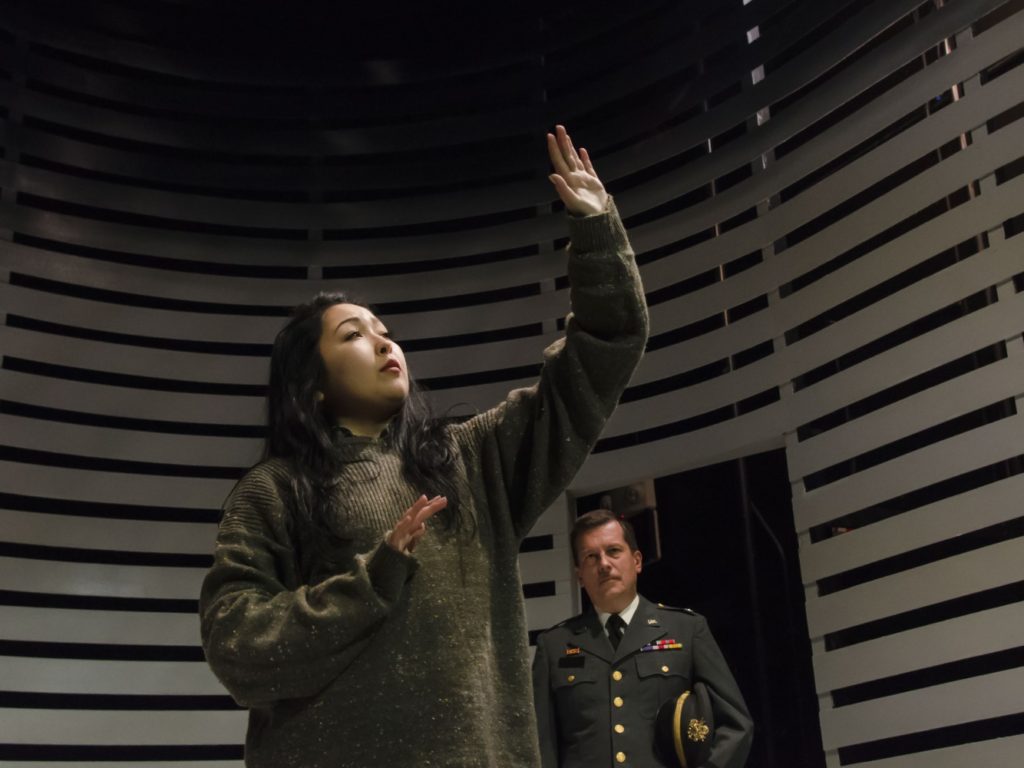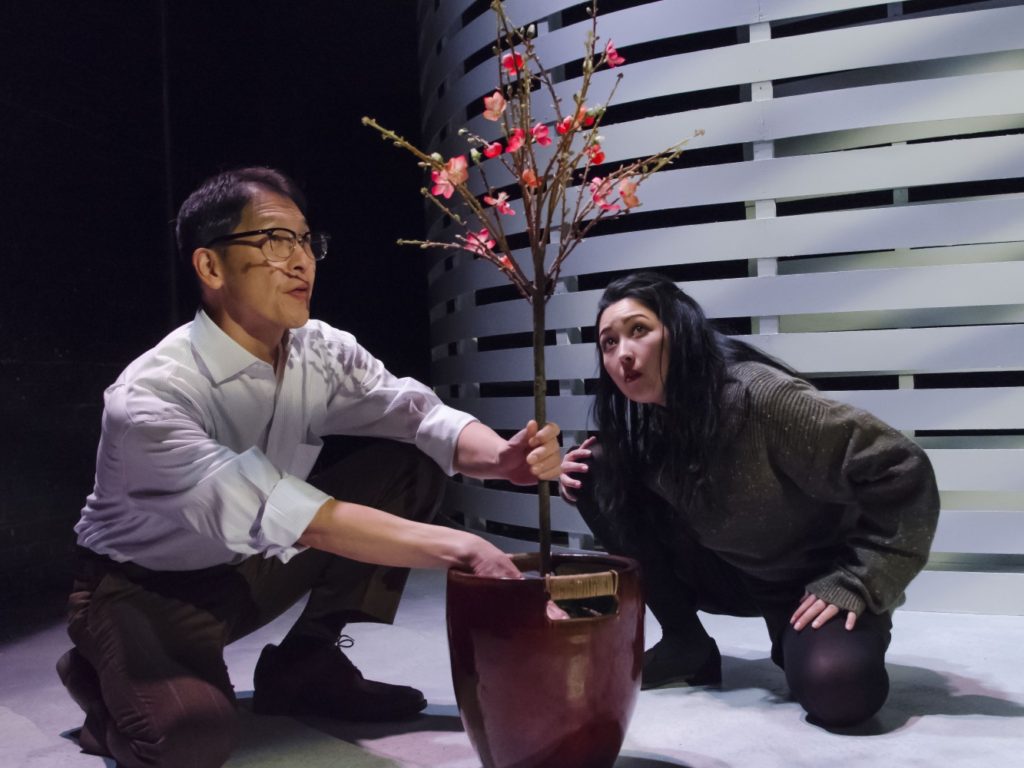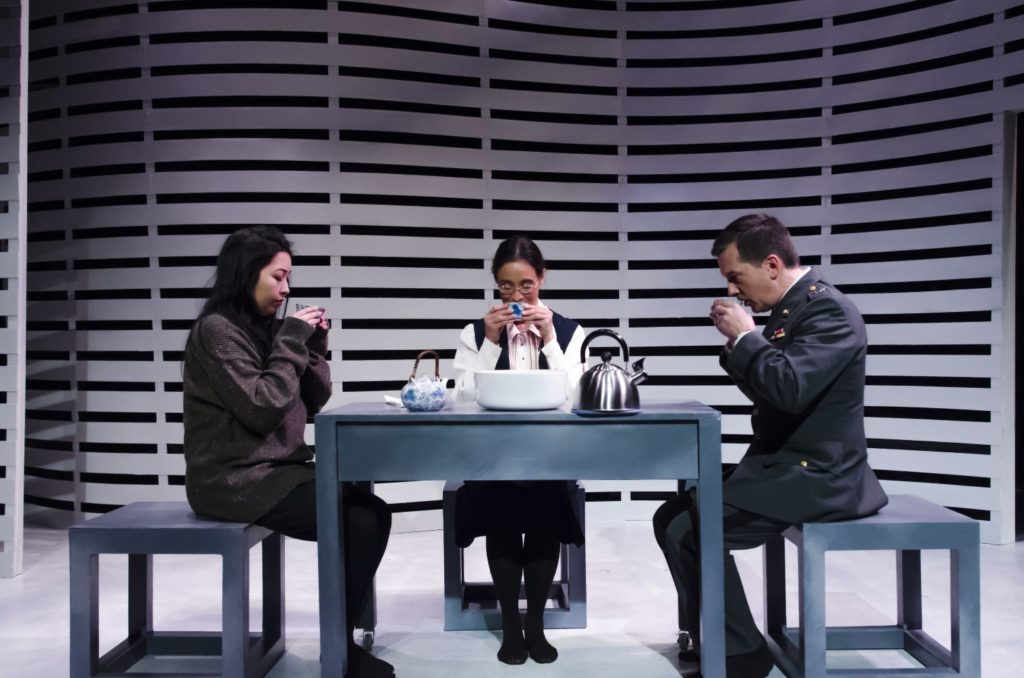Last week Maya Lin, architect of the Vietnam Veterans Memorial, came to the Smith College campus to unveil her vision for the renovation of the venerable Neilson Library. Coincidentally, in Boston a new play was unveiled which recalls Lin’s uphill battle to fulfill her idiosyncratic vision for the design of the war memorial.
Memorial, by Livian Yeh, plays through this weekend at the Boston Playwrights’ Theatre, a co-production with the Boston University graduate school of theater. The play is Yeh’s M.F.A. thesis project in playwriting at B.U. It’s directed by Kelly Galvin, also a B.U. grad student, who has taken a leave from her gig as a teacher and performer at Shakespeare & Company to pursue a directing degree. Both the script and the production are effective and moving, if stylistically less adventurous than they might be, and clearly the work of two young talents with luminous futures.
The play begins in 1981, when Lin (Amy Ward), then a Yale undergrad, learns that she has won the public competition to design the memorial. The choice by the panel of artists has been unanimous, but is immediately and explosively controversial. The issue is both artistic and personal. Lin’s plan is unconventional, to say the least – two long lateral triangles of polished black granite sunk into the ground on the National Mall, listing the names of all 58,191 American soldiers who died in Vietnam – and she herself is young and inexperienced (the design, she says, was made for her class in funerary art). What’s more, she’s a woman presuming to honor the fallen servicemen and, even worse in the eyes of her critics, an Asian, the American daughter of Chinese immigrants who, as one character says, “looks like the enemy” who the soldiers being memorialized were fighting.
Memorial is structured as a tense battle between Lin’s vision and the veterans, politicians and others who see her design for the memorial wall as an ugly, tasteless insult to the memory of those whose sacrifice it’s supposed to commemorate. It’s dismissed as “a black ditch” by one character, who wants to see a memorial “that goes up, not down [and is] white, not black,” and who wants it replaced with a heroic statue.
Of course, for anyone who knows what the memorial has come to mean for the thousands who come to the Mall to touch the names and weep, there’s no suspense. Anyone who’s been there has also seen the bronze statue of The Three Servicemen, white, black and brown, facing the wall in the memorial park – the nod to tradition that finally allowed Lin’s wall to be built, and which supplies the play’s second arena of conflict.
That critic who wants a traditional white monument is Col. James Becker (John Kooi), an apparently composite character who represents both the impetus behind the creation of a national Vietnam memorial and the official backlash against Lin’s design. The three supporting characters are drawn from life: the art and architecture critic Wolf von Eckardt (Dale J. Young, solid and avuncular), who champions her and her design in his Washington Post column; the eminent architect Hideo Sasaki (a prickly Jeff Song), one of the jurors for the design competition, whose dream of erecting a memorial to the World War II Japanese-American internment camps is used as a bargaining chip in the tussle over Lin’s project; and her hidebound mother, Julia (Roxanne Morse), who tells Lin to give up and “come home” when things get rough, but ultimately paves the way for a grudging reconciliation between artistic purity and political necessity.
The play’s mainspring is Lin’s fierce determination to preserve her vision, uncontaminated by a more conventional appendix in the form of the Three Servicemen statue (which was later joined by the Vietnam Women’s Memorial, honoring the nurses and others who also served). If Ward’s Maya Lin is a bit lacking in light and shade (as the script is as well), her passion and focus propel us powerfully through the artist’s gauntlet.
Col. Becker’s dramatic arc is broader and more interesting, and Kooi’s performance is the production’s most subtle and compelling. The play’s pivotal scene, when Becker tentatively participates in a Chinese tea ceremony with Maya and her mother, is an incisive coup de théâtre that illuminates the cultural chasm that the war exacerbated and the black wall seeks to bridge.
Just as Memorial celebrates Maya Lin as a passionate visionary, Livian Yeh’s play represents her own ardent vision – both of them young Asian women coming of age and claiming their space as artists. Add to that a majority-female design and tech team, and Galvin’s production underlines that declaration.
If the reflecting surface of the memorial compels us to see ourselves mirrored in the names etched there, Yeh’s script evokes our reflections on a array of underlying themes, particularly the impact of war and the artist’s role and responsibility in contemplating it. Mary Sader’s simple set, consisting of two curving louvered walls, sensitively lit by Aja M. Jackson, recalls both the wall itself and the winding path to its completion. The symbolism of the wall is made more potent in contrast to that other wall being proposed in this year’s election. That one, though, is cynically divisive, where Maya Lin’s wall, together with Livian Yeh’s play, call us together to reflect and forgive.
Production photos by Kalman Zabarsky (see slideshow above)
If you’d like to be notified of future posts, email StageStruck@crocker.com








